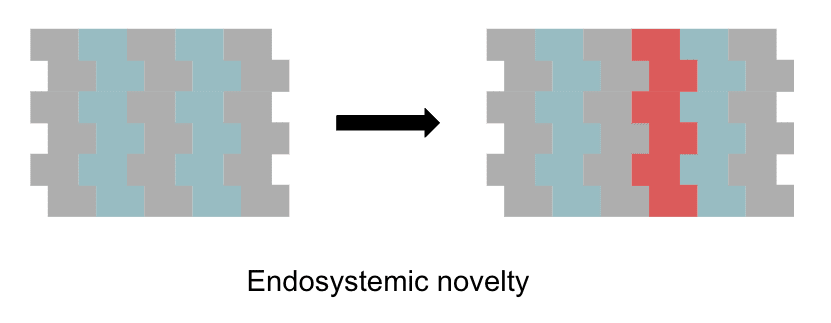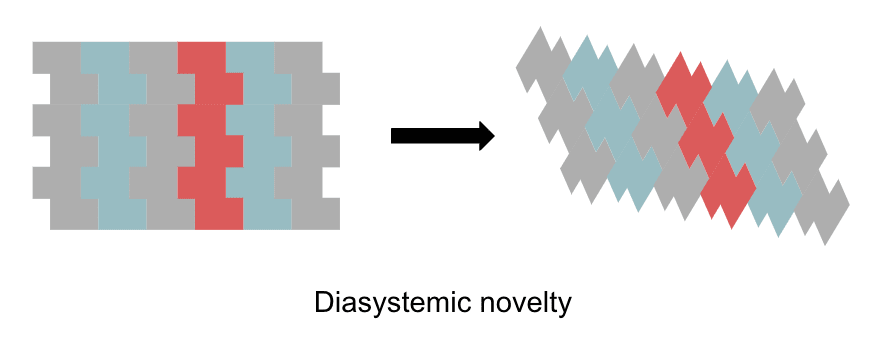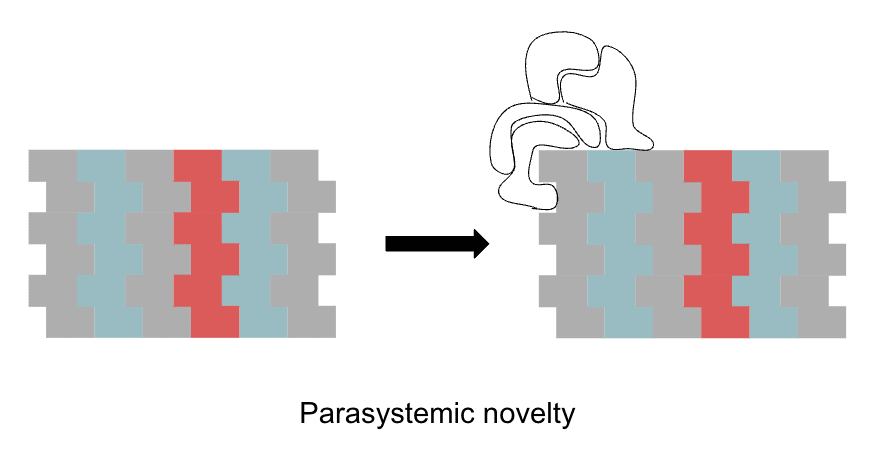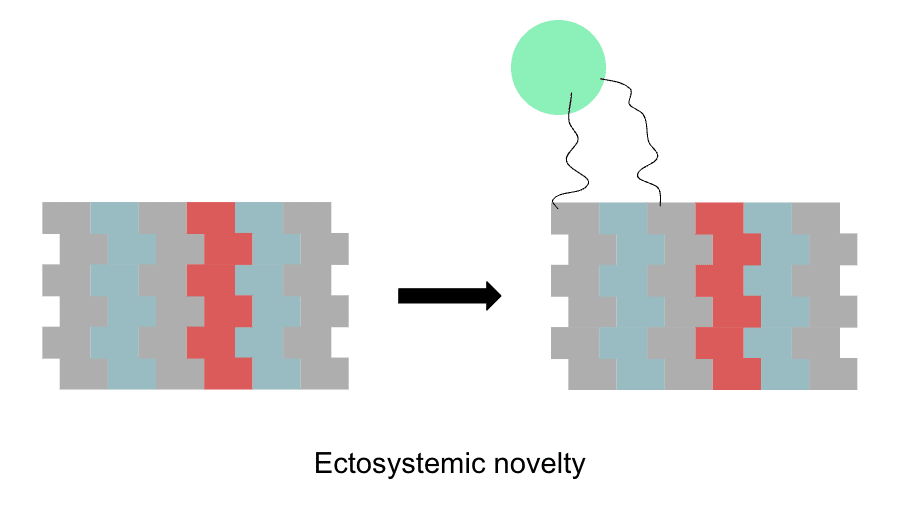Endo-, Dia-, Para-, and Ecto-systemic novelty
post by TsviBT · 2023-04-23T12:25:12.782Z · LW · GW · 3 commentsContents
Definitions Analogies Examples Exclusivity None 3 comments
[Metadata: crossposted from https://tsvibt.blogspot.com/2023/01/endo-dia-para-and-ecto-systemic-novelty.html. First completed January 10, 2023. This essay is more like research notes than exposition, so context may be missing, the use of terms may change across essays, and the text might be revised later; only the versions at tsvibt.blogspot.com are definitely up to date.]
Novelty can be coarsely described as one of: fitting within a preexisting system; constituting a shift of the system; creating a new parallel subsystem; or standing unintegrated outside the system.
Thanks to Sam Eisenstat for related conversations.
Novelty is understanding (structure, elements) that a mind acquires (finds, understands, makes its own, integrates, becomes, makes available for use to itself or its elements, incorporates into its thinking). A novel element (that is, structure that wasn't already there in the mind fully explicitly) can relate to the mind in a few ways, described here mainly by analogy and example. A clearer understanding of novelty than given here might clarify the forces acting in and on a mind when it is acquiring novelty, such as "value drives".
Definitions
"System" ("together-standing") is used here to emphasize the network of relations between elements of a mind.
These terms aren't supposed to be categories, but more like overlapping regions in the space of possibilities for how novelty relates to the preexisting mind.
Endosystemic novelty (or "basis-aligned" or "in-ontology") is novelty that is integrated into the mind by fitting alongside and connecting to other elements, in ways analogous to how preexisting elements fit in with each other. Endosystemic novelty is "within the system"; it's within the language, ontology, style of thinking, conceptual scheme, or modus operandi of the preexisting mind.
Diasystemic novelty (or "cross-cutting" or "basis-skew" or "ontological shift") is novelty that is constituted as a novel structure of the mind by many shifts in many of the preexisting elements or relations, adding up to something coherent or characteristically patterned. Diasystemic novelty is "throughout the system"; it's skew to the system, cross-cutting the preexisting schemes; it touches (maybe subtly) many elements, many relations, or certain elements that shape much of the mind's activity, hence altering the overall dynamics or character of the system.
Parasystemic novelty is novelty that is only loosely integrated into the whole mind, while being more tightly integrated within a subsystem of the mind. Parasystemic novelty is "alongside the system"; it's neither basis-aligned (since it's outside preexisting tightly integrated systems) nor cross-cutting (as it doesn't touch most of the system, or require most of the system for its constitution).
Ectosystemic novelty is novelty that is merely juxtaposed or appended to the mind, without being really integrated. Ectosystemic novelty is "on or outside the system"; it's external, only loosely related to the mind, as by a narrow interface or by an external aggregration mechanism. It differs from parasystemic novelty by being even less integrated, and by not nucleating or expanding a tightly integrated subsystem.
Analogies
- Analogy: If a language is like a mind, then a new word would be endosystemic novelty; a sound shift or (more properly) a grammatical innovation would be diasystemic (cross-cutting) novelty; specialized languages (such as scientific jargon), and dialect formation, would be parasystemic novelty; and an encounter with a foreign language would be ectosystemic novelty. Pidgins, being unstable and noncanonical, witness the ectosystemic nature: the foreign languages don't integrate. Creoles, however, could be dubbed "systemopoetic novelty"--like parasystemic novelty, in nucleating a system, but more radical, lacking a broader system to integrate into. Substrate-superstrate relations strain the analogy/example; depending on how catastrophic they are and how integrated they end up, they might be considered endosystemic novelty (e.g. in the case of gradual small-scale lexical borrowing), diasystemic novelty, or (destructive) ectosystemic novelty (replacing without integrating), from the perspective of one or the other language.
- Analogy: If a species-history is like a mind, then a new genetic variant would be endosystemic; a major transition such as the change from RNA to DNA or asexual to sexual reproduction, would be diasystemic; speciation would be parasystemic; and an encounter with alien DNA such as a virus, or another species, would be ectosystemic.
- Analogy: endosystemic novelty is like a motion along a basis vector; diasystemic novelty is like a motion along a vector that has positive dot product with many basis vectors.
Examples
- In programming, adding a function definition would be endosystemic; refactoring the code into a functional style rather than an object-oriented style, or vice versa, in a way that reveals underlying structure, is diasystemic novelty; using (especially, modifying) a library would be parasystemic; and interacting with another separate system through an API, or running the code through a profiler, would be ectosystemic.
- An example sometimes given for ontological crises is the shift from Newtonian mechanics to relativistic and/or quantum mechanics. This portrays QM as diasystemic novelty. That's not so clear to me. The situation, at least for most people, might be better described as parasystemic novelty: one has intuitive physics of everyday objects; Newtonian mechanics; relativistic mechanics; and quantum mechanics. These subsystems are tightly integrated within themselves; they relate in many ways to the overall mind and to each other; but they each relate externally much less than they relate within themselves; and they each have their own live uses.
- Usually, a "new idea" is mainly endosystemic.
- However, a "new idea" can be mainly diasystemic, or at least lead to diasystemic novelty, e.g. a novel and general epistemic practice.
- Shifts in "style" might not be novelty, in the narrow sense of new structure; e.g., sound shifts aren't really novelty, or are only barely and subtly so (perhaps by solve a problem of speaking smoothly). But some shifts in style are diasystemic novelty. For example, doing math in a more symbolically algebraic style, like , represented genuine diasystemic novelty compared to the rhetorical algebra style, like "the desired quantity, when squared and then subtracted, and the result added to one, is equal to zero" or whatever.
- Moving between cognitive realms would be extreme diasystemic novelty. New micro-realms would be parasystemic novelty.
- Solomonoff induction is "made of ectosystemic novelty": viewing SI as a sort of search process for better predictors, new predictors are novel but are just barely integrated into the preexisting system, just the barest comparison needed to allocate probability mass.
- Markets, such as Garrabrant induction, are similar, though with a little more integration.
- General intelligence built entirely out of heterogeneous components that deal with separate tasks, e.g. Drexler's Comprehensive AI Services framework, would be "a mind created entirely of parasystemic novelty". The components are loosely integrated to jointly perform tasks that require multiple services. But the components are not tightly integrated, as in an agent with centralized decision-making and fully generally broadcastable understanding.
- The endosystemic / diasystemic distinction is not the same as the implicit / explicit distinction. For example, Bayesian epistemology or functional programming is for some people diasystemic novelty encountered as an explicit idea that is explicitly propagated systemically. Though, diasystemic novelty tends to be inexplicit, maybe because it is "bigger", and because it is "the water we (fish) swim in". In the remaining quadrant, a novel skill can be endosystemic, fitting in to interoperate with pre-existing skills, without being explicit. For example, the sequence of motions you use to unlock the door to your home when departing is fairly specific, and fairly modular (it could be modified part-wise, for example if you kept your keys in a slightly different spot relative to the doorknob, with the new key-retrieval fitting in with the rest of the motions analogously to the old key-retrieval), while being probably fairly inexplicit unless you've already tried to explain it.
- Humanity as a whole has made explicit a lot of knowledge (ideas, information, theories, methods). It could be the case that this explicit knowledge would already be enough for an agent to become extremely powerful, e.g. by gaining the ability to manufacture things with atomic precision, if only the agent could gather, integrate, and apply that knowledge, without needing to create much more knowledge. If there is that much explicit knowledge, then what is missing between the state of affairs where an agent becomes very powerful, and the current situation? It seems maybe suitable to describe that difference as one of diasystemic novelty (or "systemopoetic novelty", which is sort of diasystemic novelty but ab initio de nihilo). But I would guess that in practice, it's more likely that AI systems will gain diasystemic novelty by gaining endosystemic novelty through internal creativity, rather than by reading about it.
- Merely scaling up a faculty doesn't by itself constitute novelty, but it often gives rise to novelty. For example, using a bigger neural network isn't novelty (assuming that the architecture was readily tweakable in that way, and leaving aside any novelty needed to implement that change in hardware), but can open the way toward gaining more novelty during training. Increasing the memory capacity in general of a mind is (plausibly) not novelty, but could have downstream diasystemic effects, changing the character of how many mental elements interact.
Exclusivity
Does diasystemic novelty come with necessary global changes? Or can one "think in two languages at the same time"? Maybe related, though I'm not sure: Piaget's assimilation vs. accommodation.
3 comments
Comments sorted by top scores.
comment by Mateusz Bagiński (mateusz-baginski) · 2023-06-20T10:27:57.049Z · LW(p) · GW(p)
Pidgins, being unstable and noncanonical, witness the ectosystemic nature: the foreign languages don't integrate. Creoles, however, could be dubbed "systemopoetic novelty"--like parasystemic novelty, in nucleating a system, but more radical, lacking a broader system to integrate into.
The way I think about it: ectosystemic novelty in the form of approximately unintelligible language-(community-)systems living by each other necessitates the development of an interface (pidgin), which constitutes parasystemic novelty. Initially, it has much less structure, is much less self-standing than any of the prior fully structured languages but children growing up with it imbue it with structure, developing into a creole, which becomes a new system, independent of its "parent languages".
Is this different than what you wrote or is it basically the same thing and I'm missing something?
Replies from: TsviBT↑ comment by TsviBT · 2023-06-26T19:36:24.626Z · LW(p) · GW(p)
Hm, I'm not sure. I would say that pidgins are weird. (TBC I know very little about pidgins; I'm basically just believing the general descriptions given by Bickerton, which are controversial.) I would say that a pidgin doesn't constitute much of any stable novelty. There's lots of little sparks of novelty: whenever a speaker creates a new phrase in the shared-enough basic vocabulary to communicate a subtler thing, that's a bit of novelty. But by the nature of pidgins, that novelty then often mostly disappears. A pidgin on this view is a froth of little connections forming and breaking between speakers of different languages. The pidgin-activity gives the connection that makes the more established languages / communities be parasystemic w.r.t. to each other rather than ectosystemic. But the pidgin-activity is unstable and so is harder to speak of as system or system-part on its own? I guess I'd call [the speakers's capacity to generate nonce forms on the fly] a stable part of the multi-language system?
Like, by "parasystemic novelty" I mean that if you have two systems S1 and S2, and each of them is fairly integrated within itself but they are only loosely integrated with each other, then S1 is parasystemic novelty (new stuff) from S2's perspective, and vice versa. The term sort of takes a single standpoint because I'm thinking of situations where you have a big mind that's been growing, and then you have a little bit of new stuff, and you want to describe the little bit of new stuff from the mind's perspective, so you say it's parasystemic novelty or whatever.



